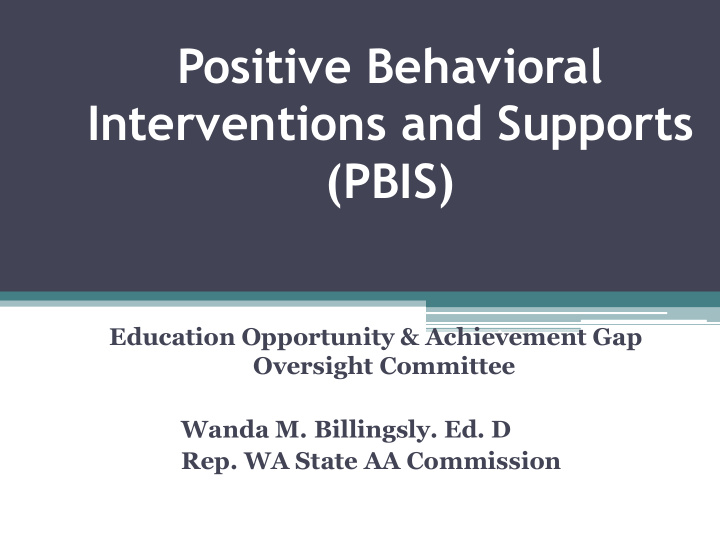



Positive Behavioral Interventions and Supports (PBIS) Education Opportunity & Achievement Gap Response to Intervention Oversight Committee Academics and Behavior Wanda M. Billingsly. Ed. D Rep. WA State AA Commission
Why a new framework? Why now? Addressing the “ Whole-Child ” Behavioral Outcomes are linked to Academic Outcomes Achievement Discipline Gap Gap Nationally • Federal Government: Guidelines for Disciplinary Practices (January, 2014) • Title I Funds released to support discipline (social/emotional) Locally • WA State Senate Bill 5946 (June, 2013) regarding expulsion and long term suspensions (limitations on duration). • WA Appleseed and Team Child Report • LAP Funds released to support discipline (social/emotional)
PBIS IS A Federally Supported Framework • National PBIS center now funded for 20 years. • In NCLB and IDEA • Vocally supported by Sec. Duncan and President Obama. • 41 States Now Have Some State Level Support • In New Federal Discipline Handbook
An implementation framework that is designed to enhance academic and social behavior outcomes for all students by (a) emphasizing the use of data for informing decisions about the selection, implementation, and progress monitoring of evidence-based behavioral practices; and (b) organizing resources and systems to improve durable implementation fidelity. ” (Sugai and Simonsen,2012). The underlying theme is teaching behavioral expectations in the same manner as any core curriculum subject. What PBIS is… * A framework to support positive behavior (academic and social behavior) *Selecting, teaching and reinforcing 3-5 school-wide behavior expectations *A system that includes collecting and using data to make informed decisions -including discipline referral system, discipline data, and progress monitoring interventions What PBIS is not… *A program *A curriculum *To be implemented in isolation
Schoolwide PBIS is Framework for enhancing adoption & implementation of Continuum of evidence- based interventions to achieve Academically & behaviorally important outcomes for All students
Give Priority to Effective Practices Less Effective More Effective Label Student Invest in School-Wide Exclude Student Teach & Reinf Soc Sk Blame Family Actively Supervise & Prevent Punish Student Individualization based on Competence Assign Restitution Consider Culture & Context Require Apology
Integrated Systems of Academic and Behavior Supports Designing School-Wide Systems for Student Success Behavioral Systems Academic Systems Intensive, Individual Interventions Intensive, Individual Interventions • Individual Students 1-5% 1-5% • Individual Students • Assessment-based • Assessment-based • High Intensity • Intense, durable procedures 5-10% 5-10% Selected Group Interventions Selected Group Interventions • Some students (at-risk) • Some students (at-risk) • High efficiency • High efficiency • Rapid response • Rapid response Universal Interventions Universal Interventions 80-90% 80-90% • All settings, all students • All students • Preventive, proactive • Preventive, proactive
Problem-Solving Process PBIS teams use data at each tier to determine problems to be addressed and to establish consistent procedures to analyze and develop solutions. Problem Identification Using data to identify and define problem behaviors Evaluation Problem Analysis Using data to determine Using data to hypothesize the effectiveness of the why the problem behavior supports and to decide identified is occurring next step Implementation Developing and implementing evidence-based behavioral supports and interventions that match the hypothesis
Evidence-Based Features of PBIS Outcomes Reduction in Office Referrals • Focus on prevention Reduction in Suspensions • Reduction in Drop Outs • Home-School partnerships Increase in Academic Gains • Established leadership teams Increase in Staff Satisfaction • Acknowledge (reward) positive behavior Increase in Student • Satisfaction Continuum of strategic group interventions Define and teach positive social expectations Continuum of intensive, individual interventions Arrange consistent consequences for problem behavior On-going collection and use of data for decision-making
The Facts About Failing to Intervene • Students who are poor readers early on are highly likely to continue to be poor readers into the secondary grades and beyond (Juel, 1988: Lyons, 2001) • Students who engage in behavior problems early on are highly likely to continue to engage in behavior problems into the secondary grades and beyond (Moffitt, 1998; Walker, Ramsey, & Gresham, 2044)
Systemic Needs: • Better system for tracking Discipline data for data based decisions • Defining behaviors universally and systemically to reduce bias and skewed data (i.e discretionary offenses) • Staff need Training and collaboration/work days and more district offered trainings for high fidelity implementation • Need district coordination from Pre-K to High School in order to implement effectively and align • Alignment across the continuum- early childhood through high school
Results from SWPBS • Reduction in Office Referrals • Reduction in Suspension • Reduction in Drop Outs • Increase in Academic Gains • Increase in Staff Satisfaction • Increase in Student Satisfaction * Return on Investment is High
Any Questions or Comments??
Recommend
More recommend